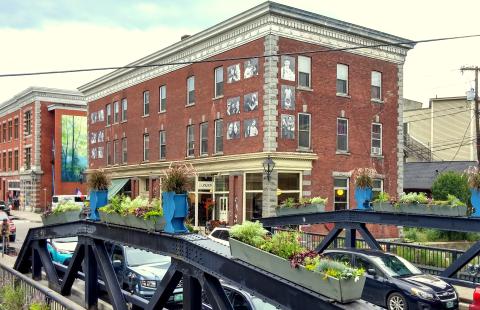What were the specific goals of this creative economy project? Describe the community development challenge or opportunity that your project was designed to address:
The starting point of Langdon Street Alive is an unexceptional single-block street that is lined with vibrant businesses, but lacks pedestrian amenities of any kind. We will redefine the character of the street by creating artistic gateway pieces at both ends, and by infusing the block with creative streetscaping, murals, sculptures and floral arts to make it more pedestrian-friendly. Langdon Street Alive will be a low-cost, high impact Tactical Urbanism project with the same objectives as last year’s Montpelier Pocket Park, which transformed an ugly vacant lot into a dynamic and beautiful public space.
Our Build a Better Block project will illustrate what more vibrant down towns look like by creating a dynamic public space in what was a poorly-defined city block. Tactical Urbanism projects like this are small and agile ways to stimulate the community’s imagination by demonstrating change more readily than infrequent, large scale projects can. These projects are especially valuable because they bring people together to create a more healthy community, one space at a time.
While Montpelier is a great place to live, its down town is overwhelmed by cars like most American cities. Montpelier’s City Council set the goal of becoming a nationally recognized bike and pedestrian friendly city, which requires re-configuring our downtown for people of all ages on foot and bike. Langdon Street is an ideal setting for pedestrian improvements and community festivals due to its compactness and existing charm, but also because its central location means the project can impact the entire downtown. We expect this project to inspire more projects of this type in other communities. To this end we will invite community planners from around the region to learn from the project.
If the goals change over time, please describe how:
We started in 2014 with a parklet, transformed it into a pocket park, and then moved up to the transformation of an entire street. Each of our projects has been larger and more challenging than the last.
Who was involved in this project and what did they do? (be sure to include the partners from outside of the creative sector and how local voices were included):
Team members:
Project Director:
Ward Joyce, public space architect and artist
Steering Committee Members:
Stephen Frey, architect and artist
Sarah Jarvis, President Montpelier Alive, Attorney at VT League of Cities and Towns
John Snell, Montpelier Tree and Pedestrian Advisory Committees, local artist
Kevin Ellis, Public Affairs Consultant and urban activist
Paul Boffa, Musician and local school teacher
Rob Hitzig, Montpelier Alive Board, local artist
Jenn Gordon, Montpelier Bicycle Advisory Committee
Marni Leikin, Director of Graduate Studies in Art and Design Education at Vermont College of Fine Arts, local artist
Gary Holloway, Downtown Program Coordinator, State of Vermont
Xavier Jimenez, Owner Buchspeiler Records, Langdon Street
Sarah DeFelice, Owner Bailey Road, Clothing Boutique, Main Street
Ben Cheney, sculptor
Partners: the following made financial or in-kind contributions last year, and we hope to have their support again:
National Life Group Foundation, Montpelier Alive, Community Engagement Lab, City of Montpelier, New England Grassroots Environmental Fund, Vermont Community Foundation, Vermont Technical College, Vermont College of Fine Arts, Montpelier High School, City of Mplr. Transportation Committee, Drawing Board
Myles Barbershop, Bailey Road, Pyralisk Arts Center, Ward Joyce Design, Arocordis Design, Rogen Design/Build, Watershed Construction, Blue and Green Gardens, DeWolfe Engineering, Casella Resource Solutions, Onion River Sports, NES Rentals, River Street Associates, Susan Ritz, Kevin Ellis, Ben & Jerry’s Foundation, Artisan’s Hand, Ondine Salon, Vintage Trailer Supply, Capitol Cab, DeGeorge Builders, Clar Construction, Washington County Courts, Fontaine Lumber + 45 individuals.
Additional project supporters: the following City officials supported the project from the start:
Ashely Witzenberger, E.D. Montpelier Alive
John Hollar, Mayor of Mplr.
Jessie Baker, Assist. City Manager
City Council, Design Review & Development Review Boards
Public Works
Tony Facos, Police Chief
Montpelier Downtown Business Association
How does this project relate to a larger community development strategy?
Tactical Placemaking is done to test ideas, to illustrate potential permanent improvements. Our work is temporary, but seeks to change the city's sense of itself.
What projects or places, if any, inspired your approach to this creative economy project?
We have studied carefully Tactical Urbanism around the country, but of particular interest is the work by NY City planners to make the city more pedestrian and bike oriented. Our PowerPoint will show best examples from around the country.
